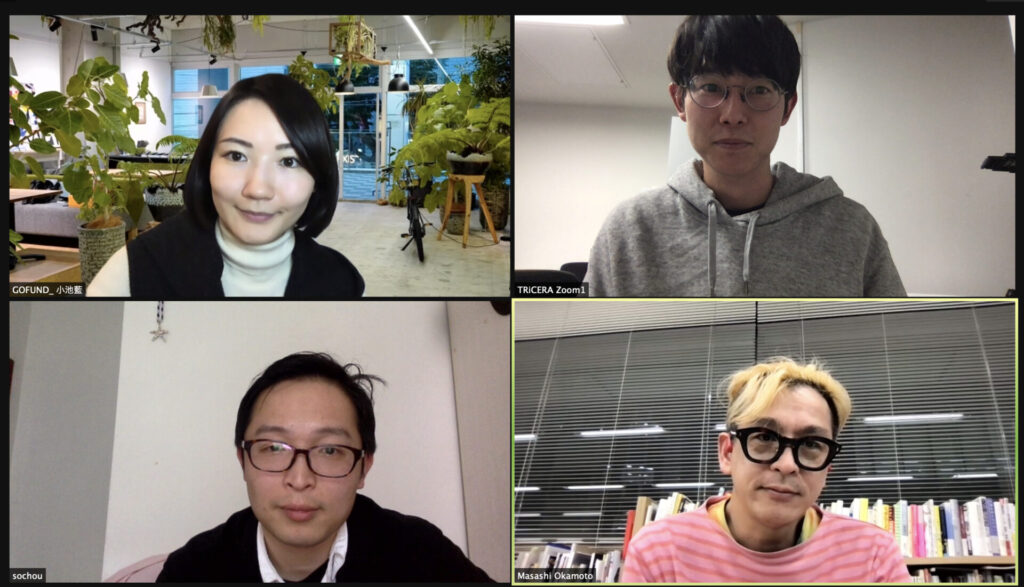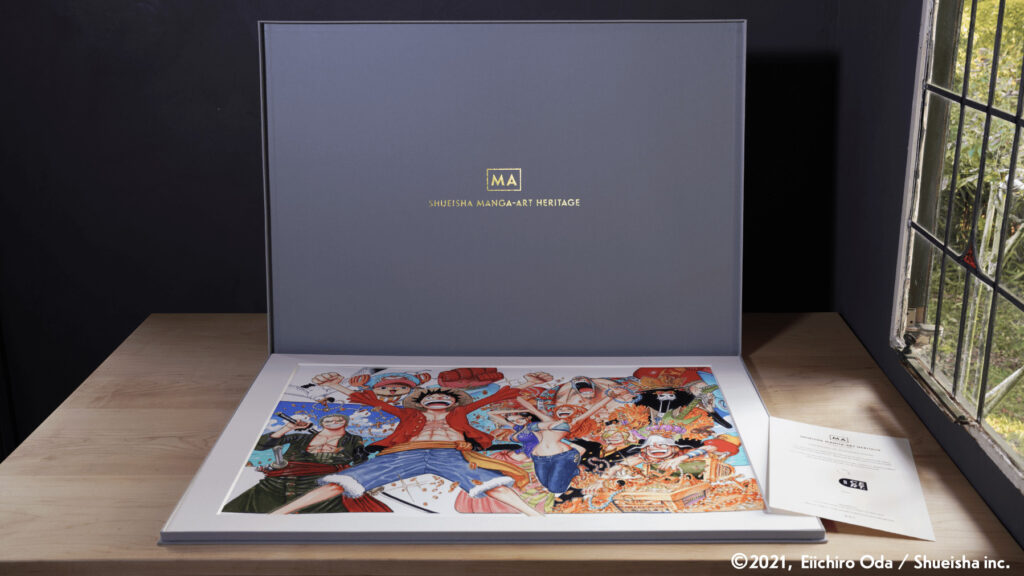Shueisha's " SHUEISHA MANGA-ART HERITAGE
" is a project to turn original manga drawings into editioned works. This time, we invited Masafumi Okamoto of Shueisha's Digital Division, collector Ai Koike, and artist Zeng Cho for a round-table discussion on the potential of "manga art" from their respective perspectives, and its interaction with the art industry.

Will art as a methodology change the inheritance of comics?
- I'd like to talk about the cross-border EC project "SHUEISHA MANGA-ART HERITAGE" started by Shueisha with its director Masashi Okamoto, collector Ai Koike, and artist Zeng Cho. First of all, Mr. Okamoto, if you could give us a brief overview of the project, I heard that the inspiration for this project was a manga archive?
Masashi Okamoto (Okamoto) Yes, it all started with the Comics Digital Archives (CDA for short), a digital archive of comics started by Shueisha around 2007. At the time, the term "digital archive" itself was still unfamiliar. As time has passed, we have been searching for other ways of outputting and communicating manga to the world, not to mention the use of digital comics, and one of the results is the "SHUEISHA MANGA-ART HERITAGE.
The first is that it's not a simple reproduction of the original, but a work of art. Finally, an archive of original manga images has been started as a project involving the Agency for Cultural Affairs, and it is based on the awareness of the problem of how to pass on paper manga to future generations. It's been a little long, but these are the three pillars on which the project was launched.
- I think there is an aspect of articulation and distribution as a way to pass on manga, and I think there is a different logic to "articulating" manga for the viewer and of course for the creator.
Okamoto: I'd like to ask how you two feel about this, but from the project side, when we think of "turning art into manga," we wonder whether it's really a good idea to bring manga into the context of fine art and distribute it. Manga has always developed in different contexts, with manga as manga and art as art. That's why we call it "MANGA-ART," with a hyphen between manga and art. I think it would be better to say that we are creating a new genre of manga art.

Ai Koike (Koike) I think this is a good way of thinking, or rather a very flexible way of thinking. I also like the fact that you chose to use cross-border EC this time. In terms of the market, the global art market is about 7 trillion yen. In terms of market, the global market for art is about 7 trillion yen, and in Japan it is much smaller, so I think it is a very good decision to target overseas markets for this kind of initiative.
Okamoto: Thank you very much. So, in Japan, it's about 350 billion yen, right?
Koike: I'd like to preface this with a "big estimate. Focusing on pure trading, it is usually said to be around 250 billion yen.
Okamoto: I see. In the case of manga, the sales of digital comics last year were about 350 billion yen. And that's just for Japan. If you include the rest of the world, or even paper comics, the market becomes much larger. Rather than daring to adapt perfectly to the style of fine art, I think it would be better for comics to utilize the context in which they've been cultivated, so that they can develop in a more fertile way. Of course, I think it's possible to collaborate with fine artists.
Koike No, I think that's really true. Add the size of the anime and manga market to the global art market of 7 trillion yen. For a long time now, there has been the idea of collecting in that world as well, with Disney celluloid pictures fetching unbelievable prices at auction. I think the idea of expanding manga as art while utilizing its unique context is very interesting.

Okamoto: When I think about that "turning manga into a work of art," I'd like to ask you, Zeng Cho, who is an artist in particular, how this genuinely looks.
Zeng Chao-san, you use oils to create works that are very textured. The artist's hand is directly involved in the work, and I think the work has a strong sense of physicality to it. This time, your manga art is different from the traditional oil paintings or works with a touch or three-dimensional feel, and focuses on flatness, but I wanted to ask you how you feel about this as a painter.
Zeng Cho: Well, in general, fine art painting focuses on materiality and physicality. They tend to value the sense of materiality more than the two-dimensional image, and I think that's a very different way of thinking from manga.
But when I say flatness, what comes to mind is Takashi Murakami's Superflat. In China, there are some works that have the context of anime and manga, but the critics don't respond well to them. They say, "The quality is higher in Japan. So, in a way, I think it's a uniquely Japanese way of thinking, or a way of making things.
- You mentioned materiality, but this time you were particularly particular about the printing, weren't you? I think the technical aspect of using a special printing technique gives it value as an object.
Okamoto: Thank you very much. It was a matter of timing, and I think I was really lucky. We had a special printing machine and a special craftsman.
For Shonen Jump, we make resin plates, which are uneven, every week and print them on a large letterpress, but this is printed on paper that is not of good quality. The paper and printing are not worth the price of a weekly manga magazine. But I wondered, "What would happen if I really printed beautifully on a letterpress? To do that, you need a letterpress flatbed press that can produce high quality prints, not a rotary press that prints at high speed. I heard that there used to be many of them in Tokyo, but there are hardly any anymore. This time, the Kyodo Printing Group found a printing company in Nagano that had one, and we asked the skilled craftsmen to do the printing.

Koike: Listening to what you just said, I was thinking about the power of a team. Basically, there is something appealing about an artist working alone with oils and acrylics, but manga is a comprehensive creation with a manga artist, an editor, and a printer.
Okamoto: That's right. Because the background of manga is actually surprisingly unknown. But these machines and techniques will be lost if we don't do something about it. It would be interesting if this could be a chance to pass them on, and I think that would be very meaningful.
Koike No, I think that's really true. Add the size of the anime and manga market to the global art market of 7 trillion yen. For a long time now, there has been the idea of collecting in that world as well, with Disney celluloid pictures fetching unbelievable prices at auction. I think the idea of expanding manga as art while utilizing its unique context is very interesting.
Okamoto: It's a world of exquisite balance, isn't it?
Koike Yes, it really is. I'm especially careful about young artists. The reason is that auctions in Japan are really gaining momentum right now, but if the price becomes too high in Japan, foreign galleries will not take a good look at it, or they will not want to handle it. If the price is too high in Japan, foreign galleries don't take a good look at it or don't want to deal with it, saying, "We can't make a profit with this. But on the other hand, if the price is low in relation to the quality, they think that there is still room for growth.
Okamoto: Oh, if the price has already been set...
Zeng Chao: Secondaries have a very strong influence in China as well. Especially in Hong Kong, it's very strong. There are some artists who get swept up in it, though.
Koike Of course, one way to do this is to work within the fixed economics of the domestic market, but depending on the stage of the artist, it may be difficult to go out into the world if the price of the secondaries only grows.
In the world of contemporary art, which requires such meticulous handling, I thought that this project would allow for more flexible thinking. Even if a secondary market were to be created, it wouldn't have a huge impact on the manga artists. Besides, it's well managed by the blockchain.

Okamoto: Blockchain is a great trigger. History will be recorded, and in the future there will be room to consider things like pursuit rights. Even the original reproductions published by Shueisha are selling for a very high price in the secondary market, and I would like to research a way to return the profits to the artists using the blockchain system.
Also, in terms of careers, I've asked three teachers to participate in this project, but I'd like to eventually ask new manga artists to participate.
I think that the structure of paper manga magazines is becoming more and more strict in many places. In addition to manuscript fees from manga magazines and royalties from comics, I think it would be good if manga art could grow into a form of income. The weight of one million yen for a debut manga artist and one million yen for a veteran is completely different...
Koike This is a new option for writers. thanks to LINE Manga and digital comics, the hurdle to becoming a writer has been lowered, but it's still difficult to make a living from it, so I think it's good that there are options like this. ...Actually, I'm teaching entrepreneurship to future artists, including manga artists, at an art university starting in April, and this is exactly the kind of thing I'm thinking about.
Okamoto: That's right. Of course, we have to deal with the issue of how to pass on manga, but on the other hand, we can also say that this is a way to be involved in the changing nature of manga itself and the careers of manga artists themselves. It's still early days, but I'd like to keep thinking flexibly about the development of the project, including what I heard today.
Profile
Masashi Okamoto | Masashi Okamoto
Director of "SHUEISHA MANGA-ART HERITAGE". After graduating from Tokyo National University of Fine Arts and Music, he joined Shueisha Co. After graduating from the Faculty of Fine Arts at Tokyo University of the Arts, he joined Shueisha Co. She has planned and implemented "Comics Digital Archives", a database of major comics published by Shueisha.
Ai Koike
was born in Tokyo in 1985. Graduated from the Faculty of Law at Keio University. After working at a start-up during her university days, she joined Hakuhodo in 2010. From 2012 to 2015, she was involved in buyout (LBO) investments, management of portfolio companies, and new business operations at Advantage Partners, a private equity fund. In 2020, he started GO FUND in Japan. In December 2020, he will become the navigator of the art YouTube program "Meet Your Art".
Zeng Chao
was born in 1985 in Hunan, China. Zeng Chao was born in Hunan, China in 1985 and graduated from Tokyo Zokei University with a doctorate in Fine Arts. With two key words, "qiyin" and "pseudosunstone", he interweaves the traditional characteristics of Chinese painting with the perspective of contemporary art to create a new and unique painting language that refers to aspects of contemporary society in his home country.
SHUEISHA MANGA-ART HERITAGE
https://mangaart.jp/